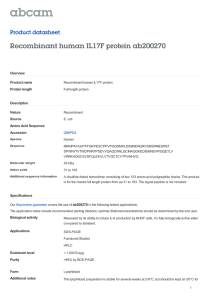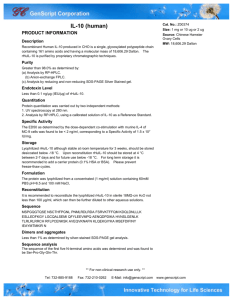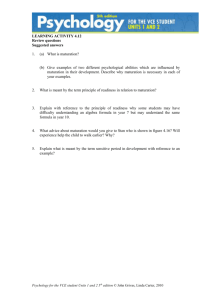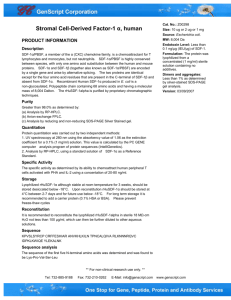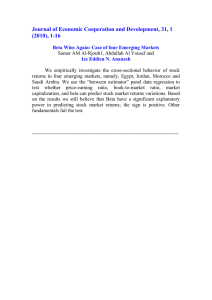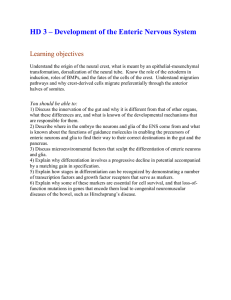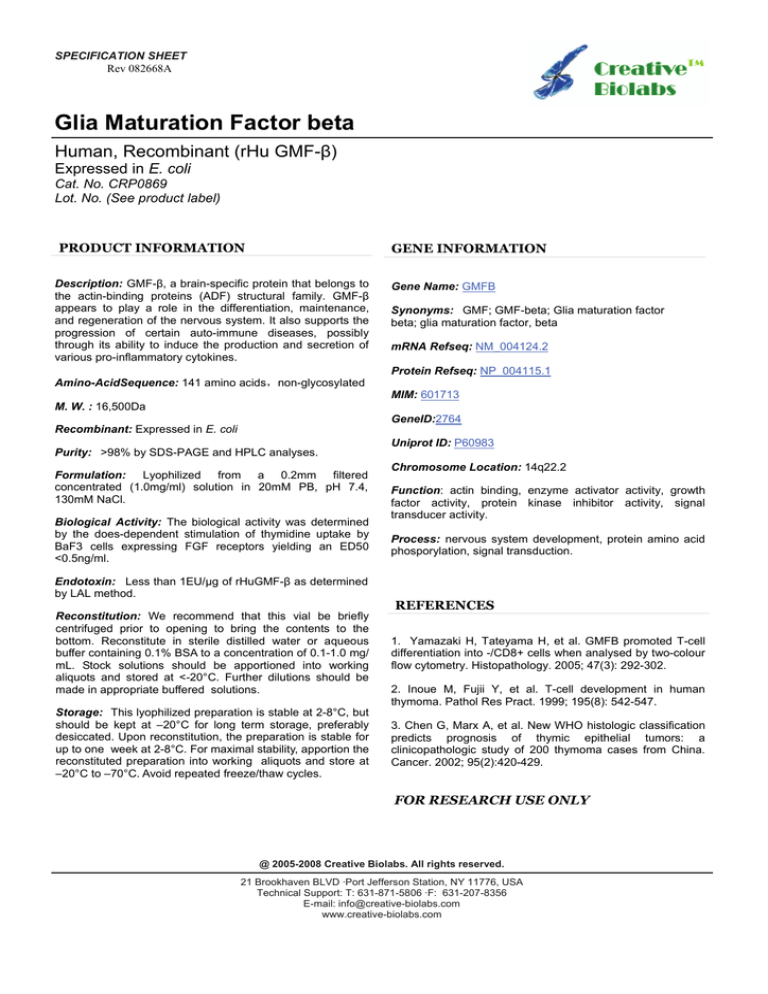
SPECIFICATION SHEET
Rev 082668A
Glia Maturation Factor beta
Human, Recombinant (rHu GMF-β)
Expressed in E. coli
Cat. No. CRP0869
Lot. No. (See product label)
PRODUCT INFORMATION
GENE INFORMATION
Description: GMF-β, a brain-specific protein that belongs to
the actin-binding proteins (ADF) structural family. GMF-β
appears to play a role in the differentiation, maintenance,
and regeneration of the nervous system. It also supports the
progression of certain auto-immune diseases, possibly
through its ability to induce the production and secretion of
various pro-inflammatory cytokines.
Amino-AcidSequence: 141 amino acids,non-glycosylated
Gene Name: GMFB
Synonyms: GMF; GMF-beta; Glia maturation factor
beta; glia maturation factor, beta
mRNA Refseq: NM_004124.2
Protein Refseq: NP_004115.1
MIM: 601713
M. W. : 16,500Da
GeneID:2764
Recombinant: Expressed in E. coli
Purity: >98% by SDS-PAGE and HPLC analyses.
Formulation: Lyophilized from a 0.2mm filtered
concentrated (1.0mg/ml) solution in 20mM PB, pH 7.4,
130mM NaCl.
Biological Activity: The biological activity was determined
by the does-dependent stimulation of thymidine uptake by
BaF3 cells expressing FGF receptors yielding an ED50
<0.5ng/ml.
Endotoxin: Less than 1EU/μg of rHuGMF-β as determined
by LAL method.
Uniprot ID: P60983
Chromosome Location: 14q22.2
Function: actin binding, enzyme activator activity, growth
factor activity, protein kinase inhibitor activity, signal
transducer activity.
Process: nervous system development, protein amino acid
phosporylation, signal transduction.
REFERENCES
Reconstitution: We recommend that this vial be briefly
centrifuged prior to opening to bring the contents to the
bottom. Reconstitute in sterile distilled water or aqueous
buffer containing 0.1% BSA to a concentration of 0.1-1.0 mg/
mL. Stock solutions should be apportioned into working
aliquots and stored at <-20°C. Further dilutions should be
made in appropriate buffered solutions.
1. Yamazaki H, Tateyama H, et al. GMFB promoted T-cell
differentiation into -/CD8+ cells when analysed by two-colour
flow cytometry. Histopathology. 2005; 47(3): 292-302.
Storage: This lyophilized preparation is stable at 2-8°C, but
should be kept at –20°C for long term storage, preferably
desiccated. Upon reconstitution, the preparation is stable for
up to one week at 2-8°C. For maximal stability, apportion the
reconstituted preparation into working aliquots and store at
–20°C to –70°C. Avoid repeated freeze/thaw cycles.
3. Chen G, Marx A, et al. New WHO histologic classification
predicts prognosis of thymic epithelial tumors: a
clinicopathologic study of 200 thymoma cases from China.
Cancer. 2002; 95(2):420-429.
2. Inoue M, Fujii Y, et al. T-cell development in human
thymoma. Pathol Res Pract. 1999; 195(8): 542-547.
FOR RESEARCH USE ONLY
@ 2005-2008 Creative Biolabs. All rights reserved.
21 Brookhaven BLVD ·Port Jefferson Station, NY 11776, USA
Technical Support: T: 631-871-5806 ·F: 631-207-8356
E-mail: info@creative-biolabs.com
www.creative-biolabs.com

